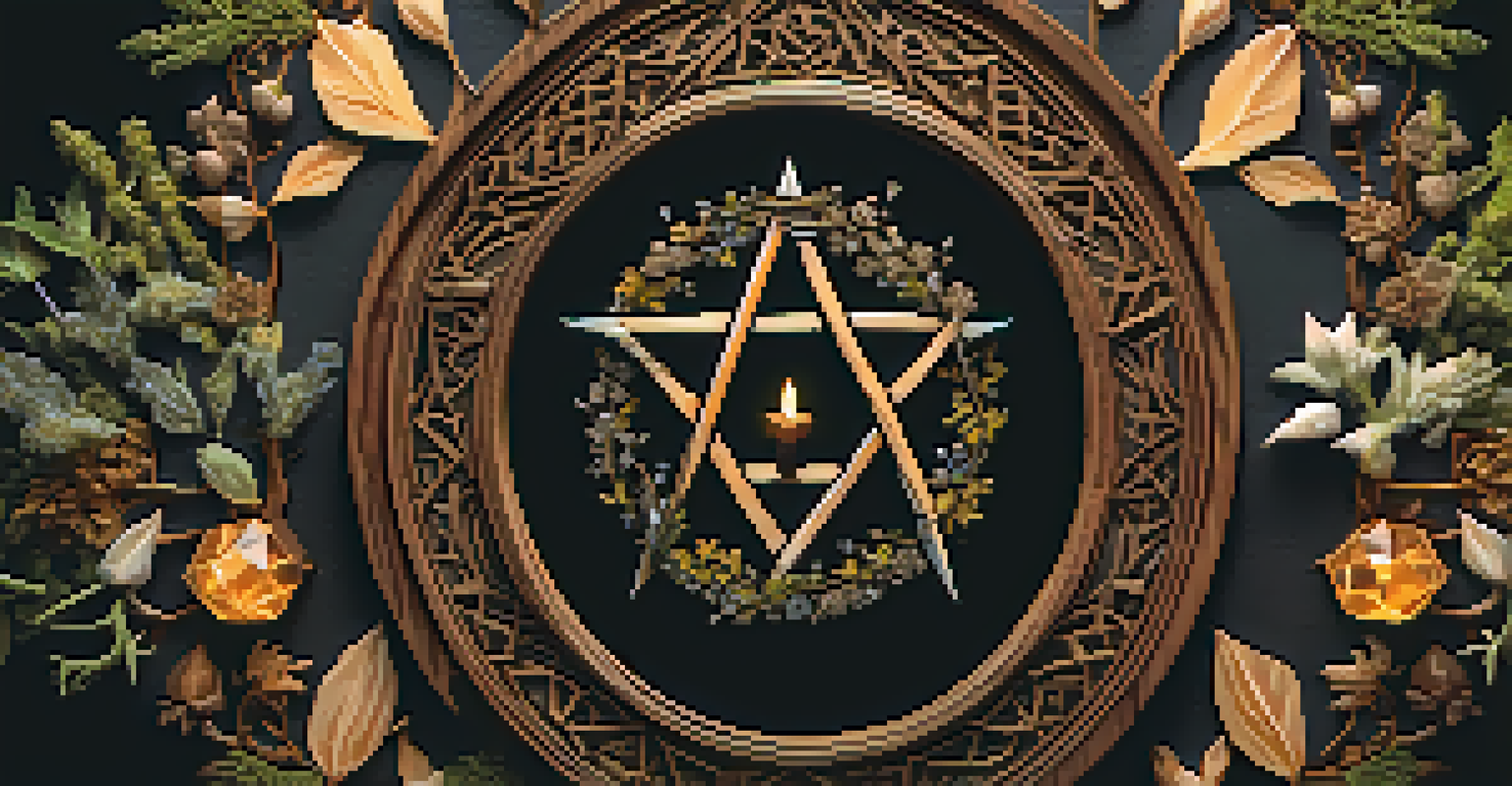Cultural Influences on Magic: Global Practices and Styles

Understanding the Roots of Magic in Different Cultures
Magic has been a fundamental aspect of human culture for centuries, serving as a bridge between the material and spiritual worlds. Each culture has its unique interpretation and practice of magic, often reflecting its values, beliefs, and historical context. For instance, ancient Egyptian magic was deeply intertwined with their religion, focusing on rituals to appease gods and protect the dead.
Magic is the science and art of causing change to occur in conformity with will.
In contrast, Indigenous cultures, such as Native American tribes, incorporate magic into their traditions through shamanism, where healing and guidance come from a connection to nature and ancestors. This diversity illustrates how magic is not a one-size-fits-all concept but rather a tapestry woven from various cultural threads. By understanding these roots, we can appreciate the rich history and significance of magical practices around the globe.
Magic, in essence, becomes a cultural lens, helping us see how societies interpret the unknown. It reveals the fears, hopes, and values that shape human experience. As we delve deeper into this subject, we'll explore specific practices and styles that highlight the fascinating interplay between culture and magic.
The Role of Rituals in Cultural Magic Practices
Rituals are a cornerstone of magical practices, providing structure and meaning to the act of magic itself. Across various cultures, rituals often involve specific actions, words, and items believed to have magical properties. For example, in Wiccan traditions, rituals may include casting circles, invoking deities, and using herbs for spells, all intended to create a sacred space for magical work.

Similarly, in African Vodun (Voodoo), rituals often involve dance, music, and offerings to spirits, emphasizing community and connection. These rituals not only serve a magical purpose but also reinforce social bonds and cultural identity. The communal aspect of these practices highlights how magic can bring people together and create a shared sense of purpose.
Magic Reflects Cultural Beliefs
Different cultures interpret and practice magic in unique ways, showcasing their values, beliefs, and historical contexts.
Through rituals, individuals express their beliefs and experiences, transforming the mundane into the sacred. This process can be both personal and communal, allowing participants to connect deeply with their culture. As we explore various magical traditions, the significance of rituals will become increasingly apparent, showcasing how they shape the practice of magic worldwide.
Symbolism and Its Importance in Magic Across Cultures
Symbols play a crucial role in magic, serving as vessels for meaning and intention. Each culture has developed its own set of symbols that resonate with their beliefs and practices. For instance, the pentagram in Western occult practices symbolizes the elements and spirit, often used in protection spells and rituals.
The world is full of magic things, patiently waiting for our senses to grow sharper.
In contrast, the Ankh, an ancient Egyptian symbol, represents eternal life and the union of opposites, frequently appearing in magical spells related to life and death. These symbols not only enrich the practice of magic but also connect practitioners to their cultural heritage. Understanding the symbolism behind these magical elements can deepen one's appreciation for the craft and its roots.
Moreover, symbols often transcend language, allowing practitioners from diverse backgrounds to communicate through the universal language of imagery. This shared understanding can foster connections between cultures, illustrating how magic can serve as a bridge rather than a barrier. As we continue to explore magical practices, the power of symbolism will emerge as a key theme in understanding cultural influences.
Magic and Spirituality: A Cultural Perspective
Magic is often intricately linked with spirituality, reflecting the beliefs and values of different cultures. In many traditions, magic is seen as a means to connect with the divine or to access otherworldly realms. For example, in Hinduism, rituals like puja are performed to honor deities, and the use of mantras is believed to invoke spiritual energy.
In contrast, in many Western magical traditions, the focus is on the practitioner's will to manifest their desires, often invoking higher powers for guidance. This divergence illustrates how cultural beliefs shape the understanding of magic and its purpose. While some view it as a tool for personal empowerment, others see it as a way to honor and connect with the divine.
Rituals Unite Communities
Rituals are essential in magical practices, reinforcing social bonds and cultural identity while transforming the mundane into the sacred.
Exploring the spiritual dimensions of magic reveals the profound impact of culture on individual practices. As practitioners navigate their spiritual journeys, they often draw from their cultural backgrounds, creating a rich tapestry of beliefs and practices. This dynamic interplay between magic and spirituality is a vital aspect of understanding its role in various cultures.
Regional Variations: Magic in Different Geographies
Geography plays a significant role in shaping magical practices, with regional variations reflecting local beliefs, resources, and traditions. For instance, in the Arctic regions, Inuit shamanism incorporates the natural environment, emphasizing harmony with the land and the spirits that inhabit it. This connection to nature is a defining feature of many indigenous magical practices across the globe.
Conversely, urban magical practices may draw from a mix of traditional and contemporary influences, often resulting in eclectic styles. In cities like New Orleans, you can find a unique blend of African, French, and Spanish magical traditions, creating a vibrant cultural tapestry. This regional diversity not only enriches the practice of magic but also showcases how cultures evolve and adapt over time.
Understanding regional variations in magical practices highlights the importance of context in shaping beliefs and rituals. As we explore these differences, we gain insight into how geography influences the way magic is perceived and practiced. This perspective allows us to appreciate the richness of global magical traditions and their unique expressions.
Magic in Modern Society: Cultural Appropriation vs. Appreciation
As magic gains popularity in modern society, the conversation around cultural appropriation versus appreciation has become increasingly relevant. Many contemporary practitioners draw inspiration from various magical traditions, sometimes without fully understanding their cultural context. This can lead to misrepresentation and disrespect for the very cultures that originated these practices.
On the other hand, when approached with respect and understanding, cross-cultural exchange can enrich magical practices. For example, incorporating elements from different traditions can create a more inclusive and diverse magical community. However, it's crucial to acknowledge the origins of these practices and honor the cultures they come from, fostering a sense of respect and collaboration.
Navigating Cultural Appropriation
Modern magical practices face the challenge of cultural appropriation, emphasizing the need for respect and understanding in cross-cultural exchanges.
Navigating this complex landscape requires mindfulness and a willingness to learn. By engaging in open dialogues about cultural influences on magic, practitioners can create a more respectful and informed community. This balance between appreciation and appropriation is essential for preserving the authenticity of cultural practices while celebrating their evolution.
The Future of Magic: Global Interconnections and Innovations
As our world becomes more interconnected, the future of magic is likely to reflect this global exchange of ideas and practices. Technological advancements, such as social media and online communities, have made it easier for practitioners from different cultures to share their knowledge and experiences. This can lead to exciting innovations in magical practices as cultures blend and evolve.
However, this globalization also poses challenges, as the risk of homogenization threatens the authenticity of traditional practices. It's essential for practitioners to remain grounded in their cultural roots while embracing the potential for growth and transformation. By honoring the past and being open to new ideas, the future of magic can be both rich and diverse.

Looking ahead, the dialogue surrounding cultural influences on magic will continue to evolve. As we navigate this landscape, it’s important to prioritize respect, understanding, and collaboration. By doing so, we can foster a magical community that celebrates both tradition and innovation, ensuring that the practice of magic remains a vibrant and meaningful part of our global culture.